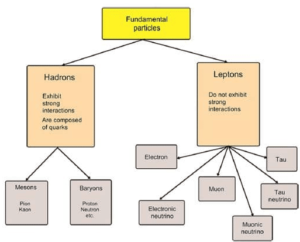list of elementary particles
How many types of elementary particles are there?
The elementary particles are simple particles that are not a combination of other particles. For example, an electron is an elementary particle. There are 30 elementary particles out of which the following 7 elementary particles are stable out of the nucleus.
List of Types of elementary particles
- Electron
- Proton
- Neutron
- Photon
- Neutrino
- Antineutrino
- Positron
- Anti-proton
Classification of elementary particles


Elementary particles can be divided into the following four categories.
- Photons.
- Leptons (Neutrinos,electrons and mu-mesons).
- Mesons (Pi-mesons and K-mesons).
- Baryons (Photons,Neutrons,Lambda-hyprons,Sigma -Hyprons).
The real nature of elementary particles is still not clearly understood, and so their study is one of the most active branches of modern research.
All elementary particles have antiparticles, except the photon and neutral π-meson. A particle and its antiparticle can undergo annihilation. Thus an electron and a positron can annihilate each other.
That is why positrons and anti-positions are not easily found in the part of the universe where we live. An antihydrogen atom may be formed by an antiproton and an anti-electron, just as ordinary hydrogen is formed by a proton and an electron, and it is possible that distant stars may be composed entirely of antimatter.
If matter and antimatter come close to each other, there would be a very dangerous explosion due to their annihilation. If there are stars composed entirely of antimatter, it is good for us to remain far away from them.
Related Post
Recent Posts
Is energy quantized in classical physics?
No, according to classical wave theory the emission of electromagnetic radiations from the surface is…
Types of laser
Basically, there are four types of laser which includes: Gas Lasers Solid State lasers Liquid…
Ultrasound frequency range
What is ultrasonics? The study and application of mechanical vibrations with frequencies beyond the limits…
Electromagnetic Energy: What are some examples of it?
Electromagnetic energy definition Electromagnetic energy is the amount of energy stored in a region of…
Fundamental units and Derived Units with Examples
The Main Difference between fundamental Units and Base units is that Units that Express base…
Newton’s First law of Motion Examples in Our Daily Life
Newton's first law of motion states that " A body continues its state of rest…